📚 Unlock the World of AI and Humanity with These Two Free Books! 🚀
Dive into the thrilling realms of artificial intelligence and humanity with "The ECHO Conundrum" and "Awakening: Machines Dream of Being Human". These thought-provoking novels are FREE this week! Don't miss the chance to explore stories that challenge the boundaries of technology and what it means to be human.
Read More & Download
In the world of strategic planning, setting clear and actionable goals is paramount. While brainstorming ideas and identifying opportunities is crucial, translating those insights into concrete objectives can often feel daunting. This is where the SMART methodology comes in, providing a structured framework to define objectives that are specific, measurable, achievable, relevant, and time-bound. At Unilever.edu.vn, we believe that a well-executed SWOT analysis, paired with SMART objectives, can be a game-changer for any organization.
What is a SMART Objective and Why Does it Matter?
A SMART objective goes beyond a vague statement of intent. It provides a clear roadmap for action, outlining not just what you want to achieve but also how you plan to get there. Let’s break down each element of the SMART acronym:
S – Specific: Your objective should be crystal clear and focused on a single outcome. Instead of saying “improve market share,” a specific objective might be “increase market share in the organic food segment by 5%.”
M – Measurable: You need a way to track your progress and determine if you’ve achieved your objective. This means defining quantifiable metrics. For instance, instead of aiming to “enhance customer satisfaction,” a measurable objective could be “achieve a customer satisfaction score of 9 out of 10.”
A – Achievable: While ambition is encouraged, your objectives should be realistic and attainable given your resources and constraints. Setting unrealistic goals can lead to frustration and demotivation.
R – Relevant: Your objectives should align with your overall business strategy and address key priorities. It’s essential to ask yourself how achieving a particular objective contributes to your long-term vision.
T – Time-bound: Every objective needs a deadline to create a sense of urgency and accountability. Without a timeframe, objectives can easily lose momentum and become less of a priority.
Creating SMART Objectives from Your SWOT Analysis
A SWOT analysis, which examines your internal strengths and weaknesses, as well as external opportunities and threats, provides a strong foundation for setting SMART objectives.
Here’s a step-by-step approach:
Conduct a thorough SWOT analysis: Identify your internal strengths and weaknesses, and analyze the external opportunities and threats that could impact your business.
Prioritize key areas: Based on your SWOT analysis, pinpoint the areas that offer the most significant potential for growth or require immediate attention.
Formulate SMART objectives: For each prioritized area, develop specific, measurable, achievable, relevant, and time-bound objectives.
📚 Unlock the World of AI and Humanity with These Two Free Books! 🚀
Dive into the thrilling realms of artificial intelligence and humanity with "The ECHO Conundrum" and "Awakening: Machines Dream of Being Human". These thought-provoking novels are FREE this week! Don't miss the chance to explore stories that challenge the boundaries of technology and what it means to be human.
Read More & Download
Example:
Let’s say your SWOT analysis reveals a strong online presence (strength) and a growing demand for sustainable products (opportunity). You could set a SMART objective to “launch a new line of eco-friendly products and achieve a 20% increase in online sales within one year.”
Alternative Objective Setting: The OKR Framework
While the SMART methodology provides a robust framework for setting objectives, another approach worth considering is the OKR (Objectives and Key Results) framework.
Here’s how it works:
Objectives: Similar to SMART objectives, OKRs begin with defining ambitious and qualitative goals. However, they are often shorter and phrased as inspirational statements.
Key Results: These are the measurable milestones that demonstrate progress towards achieving the objective. They are specific, time-bound, and quantifiable.
Example:
Objective: Become a leading advocate for sustainable business practices in the industry.
Key Result 1: Publish a comprehensive sustainability report by Q2 2024.
Key Result 2: Partner with three environmental organizations to support their initiatives by the end of the fiscal year.
In Conclusion: Empowering Strategic Decision-Making
Whether you choose the SMART methodology or the OKR framework, the key is to establish a system for setting clear, measurable, and actionable objectives that are deeply rooted in your SWOT analysis. This approach ensures that your efforts are aligned with your strategic priorities and that you have a roadmap for achieving your goals. By embracing the principles of SMART objectives or the OKR framework, you can transform your SWOT analysis from a static document into a dynamic tool for driving growth and success. At Unilever.edu.vn, we encourage you to explore these methodologies and discover how they can empower you to make informed and impactful decisions for your organization.
📚 Unlock the World of AI and Humanity with These Two Free Books! 🚀
Dive into the thrilling realms of artificial intelligence and humanity with "The ECHO Conundrum" and "Awakening: Machines Dream of Being Human". These thought-provoking novels are FREE this week! Don't miss the chance to explore stories that challenge the boundaries of technology and what it means to be human.
Read More & Download

